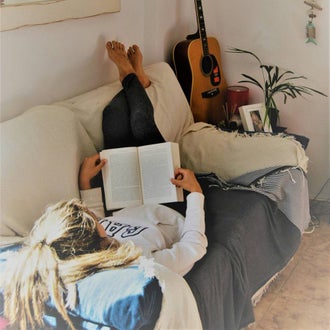Misinformation online or in the media can cause confusion about cancer risks, but don’t worry we’re here to clear things up. Let’s explore this question about wearing sunscreen indoors in a little more detail.
Summer from Kensington asked:
Should I wear sunscreen when indoors?"
As the risk of sun exposure is low when indoors, sunscreen is unnecessary.
However, if you are spending a lot of time by a window with direct sunlight you might consider sun protection - although clothing may be sufficient and sunscreen unnecessary.
To answer this question, let’s consider solar ultraviolet radiation (UVR), which is invisible energy produced by the sun. The two types of UVR that reach the earth are UVA and UVB. UVA primarily contributes to skin ageing but also increases skin cancer risk, whereas UVB is the major cause of sunburn and increased risk of developing skin cancer. UVB is typically blocked by glass, and certain types of glass can reduce UVA; for example, laminated glass eliminates UVA completely.
UVR exposure through windows presents minimal risk of skin damage, so if you are spending most of your time indoors (particularly during the middle of the day when the UV Index is highest) sunscreen is most likely unnecessary.
But if you are going outside during the day - for example hanging out the washing or gardening - and the UV is forecast to reach 3 or above, then sun protection should be incorporated into your routine before heading outside. If you are spending a lot time inside, by a closed window with direct sunlight, you may consider some sun protection (such as clothing) but sunscreen may not be necessary.
Remember to check the UV, when it’s forecast to reach 3 or higher and you are heading outdoors to use five forms of sun protection – slip on clothing, slop on a broad-spectrum water-resistant sunscreen with an SPF30 or higher, slap on a broad-brimmed hat, seek shade and slide on sunglasses.
There is typically no need to wear sunscreen when indoors, as the risk of sun exposure is low. If you are spending a lot of time by a window with direct sunlight you might want to think about sun protection, though clothing may be sufficient and sunscreen won’t usually be necessary.
To explain the risk, it is important to understand UVR. Solar UVR (Ultraviolet radiation) is invisible energy produced by the sun. The two types of UVR that reach the earth are UVA and UVB. UVA primarily contributes to skin ageing but also increases skin cancer risk, whereas UVB is the major cause of sunburn and increased risk of developing skin cancer. UVB is typically blocked by glass, and certain types of glass can reduce UVA, for example laminated glass eliminates UVA completely.
While UVR exposure through windows presents minimal risk, if the UV level is forecast to be 3 or above and you are going to be outside intermittently during the day, for example to carry out chores like hanging out the washing, then sun protection, including sunscreen use, should be incorporated into your morning routine.
Remember to check the UV and when it’s 3 or higher and you are heading outdoors to use five forms of sun protection – slip on clothing, , slop on SPF 50 or SPF50+ broad-spectrum, water-resistant sunscreen, slap on a broad-brimmed hat, seek shade and slide on sunglasses.
iHeard hub
Thank you for joining the mission against misinformation
If you’ve heard a rumour about cancer, or are unsure about information you’ve read online, ask your own cancer question via the iHeard hub.
We want everyone to have the correct information about cancer so if you know anyone else with a cancer question, why not let them know about iHeard?
This article was last updated 17/04/2025.
Author: Claire Wharton, Writer, Cancer Council Australia
Article reviewed by: Dr Amelia Smit, Research Fellow (Melanoma and Skin Cancer), The Daffodil Centre, The University of Sydney

